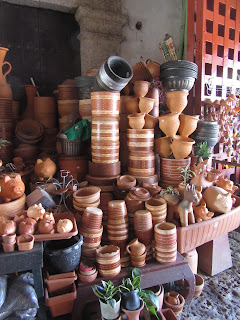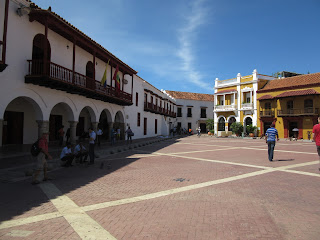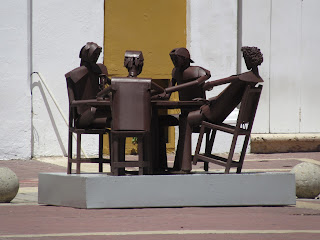Note: The photos in this post actually span the entire time we spent in Cartagena as we saw most of the places at least twice so I have taken the liberty of choosing the best ones.
We have traveled to well more than 60 countries, mostly together since we began our long overseas trips in the fall of 2013. Never, however, until our Avianca flight landed in Cartagena from Panama City via Bogota has one of us not had a bag join us in the new city - my red bag wasn't among all the others on the luggage carousel. After filling out the requisite form and hoping it would be delivered to our hotel later that night, we were on our way into the city. For the next few hours, I kept thinking of some of the items I'd needed to pack for the trip and would be hard to replace as we're going to some unsual places this time, even for us.
We chose to make Cartagena our first destination in Colombia as it vied with Peru’s Cusco and Brazil’s Ouro Preto, as one of the continent’s “most enthralling and righteously preserved colonial destinations.” Luckily, since our itinerary also includes stops in the other cities later in the trip, we’ll be able to see how Cartagena stacks up.
In the period of greatest influx of black population in the city, the 'Plaza de los Coches' was known as Slave Square as it was a popular marketplace for buying and selling human beings brought from Africa. A Jesuit priest in 1618 wrote that "Merchants go to the coasts of Angola and Guinea to buy them at vile prices; they bring them in overloaded vessels to this port where they'll sell them for an incredible profit."

The plaza was dominated by the austere Iglesia de Santo Domingo but
it was overshadowed by the rotund, nude bronze sculpture by the famous
Colombian sculptor Fernando Botero
directly in front of the church!
It was neat coming across the immediately identifiable image of Juan Valdez, the man in the coffee commercials wearing his sombrero astride his horse, that I remembered from coffee commercials. Turns out there were several cafes named after him throughout the city.
We could hear the pounding of drums, other instruments being played and people singing nearby. We realized that the music was coming from Plaza Bolivar so we returned to see and hear what was happening. We stayed for a good while watching the dancers and the musicians as they put on an imprompty concert in teh park.
How I wish I had their wonderful sense of rhythm and a speck of their dancing ability!
We have traveled to well more than 60 countries, mostly together since we began our long overseas trips in the fall of 2013. Never, however, until our Avianca flight landed in Cartagena from Panama City via Bogota has one of us not had a bag join us in the new city - my red bag wasn't among all the others on the luggage carousel. After filling out the requisite form and hoping it would be delivered to our hotel later that night, we were on our way into the city. For the next few hours, I kept thinking of some of the items I'd needed to pack for the trip and would be hard to replace as we're going to some unsual places this time, even for us.
We chose to make Cartagena our first destination in Colombia as it vied with Peru’s Cusco and Brazil’s Ouro Preto, as one of the continent’s “most enthralling and righteously preserved colonial destinations.” Luckily, since our itinerary also includes stops in the other cities later in the trip, we’ll be able to see how Cartagena stacks up.
Cartagena is Colombia’s 5th largest city. The city’s full name
is Cartagena des Indias to
differentiate it from Cartagena in Spain and also to reflect the city’s
indigenous peoples and Caribbean and African roots. The city was founded by
Pedro de Heredia in 1533 on the site of the Carib settlement of Calamari.
Within a short time, it blossomed into the main Spanish port on the Caribbean
coast and the major northern gateway to South America.
As Cartagena’s old city is its principal attraction, we’d
booked a room in a hotel in Getsemani, a more affordable area just a few
minutes’ walk away and described as ‘less obviously impressive with its modest
architecture.' Read between those lines and you understand that meant the area was
grittier and had plenty of ‘atmosphere’ as the home of many backpacker hostels and less affluent hotels! After dumping Steven's bag in the hotel, we walked through Centennial Park toward the Old Town, just a short hop away. We stopped for a moment in Cervantes Plaza before proceeding with the self-guiding walking tour of the area's plazas or city squares.
We started our tour of the old city at the Plaza de los Coches or Carriage Square, once the main
entry point to the city and just a few minutes’ walk from our hotel.
The plaza
was easy to find by the iconic, republican style, 19th century clock
tower that topped the entrance through the wall into the El Centro area and is
considered to be the symbol of the city.
One of the passageways in the wall was known as the Customs Door as it was the direct communication with the dock where the goods that came in and out of the city arrived. For a long time it became the slave landing site of Cartagena and crossing it meant entering into a world of slavery without return. Now, the passageway served as another outlet to sell items to tourists.
Inside the plaza was a statue to the city’s founder, Pedro
de Heredia.

Lined with old balconied houses with colonial arches at
ground level, the plaza made for a beautiful introduction to the old city.
Across from the plaza entrance was the Portal de los Dulces, a row of confectionery stands where
Afro-Colombian women sold local, homemade sweets, often made from coconut and
tamarind.
Right around the corner from Carriage Square was Plaza de la Aduana, once
the seat of power in Cartagena as the
former Customs building and now the City Hall. It was the largest square in town
and was once used as a parade ground.
Our walking tour guide told us a couple of days later that it was here that the slaves were brought to be sold. When 20-25% of them perished en route to Colombia, their bodies were
dumped overboard. Those that survived the voyage after only being fed bread and
water were subsequently fed well so they would fetch a high price. At the slave
markets held just twice a year, the slaves were oiled so they would appear
fitter. They were priced according to their age, health, etc; I was surprised
to learn that older, male slaves were the most sought after because they had
skills to teach younger slaves.
The large statue of Christoper Columbus seemd rather out of place to me in Customs Square.
Across the sqaure were several metal sculptures created by a local artist.
Dominoes is a very popular and intensely competitive game for residents of Cartagena; losers either ante up money or beer!
This image will make more sense a little further into the post!
The wide gold band in the country’s flag represents the
country’s gold; the same sized blue and red bands represent the sea and blood
shed in the quest for independence, respectively.
A stone's throw away from Customs Plaza was Plaza de San Pedro
de Claver, a small but charming square, which took its name from the convent and church where lie the bones of the saint. The imposing stone façade of the church was originally founded by Jesuits in the
first half of the 17th century and was later renamed to honor the
Spanish-born monk Pedro Claver.
Called the ‘Apostle of the Blacks’ and the
‘Slave of the Slaves,’ Claver spent his life ministering to the enslaved people
brought to the region from Africa. The monk was the first person to be
canonized in the New World in 1888.
We had hoped to enter the church and attached convent so we could view
the small cell where the saint lived and died but they were both closed each
time we wandered by.
When we first saw women wearing the gaily decorated dresses and holding huge platters of fruit on their heads, it all but took my breath away. Our walking tour guide joked a couple of days later that the women charged a
‘copyright’ in order for tourists to take their pictures. The ‘copyright’ was
either purchase a package of prepared sweets or tip them a couple of dollars.
The Plaza de Santo Domingo was located in the heart of the former upper-class quarter, called El Centro. There were a number of superb two-story homes that had been built by rich merchants.
Seeing the Bourbon St. Live Music sign in Plaza de Santo Domingo was definitely NOT what we expected even in a touristy town like Cartagena!
Legend has it that anyone hoping to return to Cartagena must
touch both boobies. If you only touch other parts of her body, you have just a
75% chance of visiting the city again. Evidently, a lot of people must be returning to the city at some point judging by the discoloration on certain parts of her anatomy! I hope, dear readers, you aren’t too prudish as there’ll be many more photos of Botero’s sculptures in further posts about Colombia.
When we saw the church our first evening, mass was almost
ending so we stayed as the ambience and atmosphere from the musicians and
parishioners was so uplifting and positively contagious.
Seeing the priests communicate
with their parishioners in such a heartfelt way was a first for me, even as a
lifelong Catholic. I could feel myself tearing up at the sense of emotion.
I was particularly touched by
the stone floor in front of the high altar and in two aisles as it was paved
with old tombstones, mostly dating from the 19th century.
The church is reputedly the oldest church in the city and
was built in 1539 in Plaza de los Coches before being rebuilt in this plaza
after the other had burned down. The builders mustn’t have been very good with
their calculations as the vaulted ceiling began to crack and the bell tower was
distinctly crooked! The figure of Christ carved in wood set in the baroque altar
in a side aisle was quite splendid.
The
leafy and shaded Plaza Bolivar provided a welcome respite a couple of times for us from the sweltering Caribbean heat. The
statue of the eponymous Simon Bolivar in the middle was created by a German
artist.
We could hear the pounding of drums, other instruments being played and people singing nearby. We realized that the music was coming from Plaza Bolivar so we returned to see and hear what was happening. We stayed for a good while watching the dancers and the musicians as they put on an imprompty concert in teh park.
How I wish I had their wonderful sense of rhythm and a speck of their dancing ability!
Our stomachs began to growl so we tore ourselves away and headed back to Plaza de Santo Domingo where several restaurants on the square had set up tables. While waiting for our dinner to arrive, two guitar players serenaded the people at the next table.
Taking a leisurely stroll back to our hotel through the charming city was the perfect ending to a lovely day. It even got better when my suitcase was delivered to our door later that evening!
Next post: Seeing the Pope and touring more of Cartagena.
Posted from Santa Marta, Colombia on September 12th.















































Oh what history, what colour, what music, what dance ! And speaking of dance, I believe you too showed great rhythm "under the tent" in Paw Paw. Much love to you and Steven, Lina xo
ReplyDeleteLina,
DeleteYou give me far too much credit for my dance moves - that's why, I so appreciate the art of dancing in others!
Oh! Annie,
ReplyDeleteI have been enjoying the pictures and reading your stories, I really like the colour the dancers, the history.
My dear Gloria,
DeleteThrilled to hear you're enjoying the photos and reading my tales about our adventures. I only hope I am doing justice to your homeland! I would love to know if you've also been to Cartagena and Santa Marta?
Hugs to you and Paul!
This comment has been removed by the author.
ReplyDeleteThat was really surprising to hear about how the older Male slaves were worth the most. In all of my history classes, I have never heard about this.
ReplyDeletePerhaps that tale was a matter of artistic liberty on the part of the free walking tour guide? Don't know, hon! Thanks for reading the post.
ReplyDelete